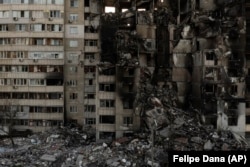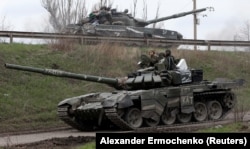After nearly three months of war with Russia, Ukrainian forces are beginning to launch counterattacks against Russian positions and redraw the battle map in the process.
The British Defense Ministry said in an intelligence update on May 12 that Ukraine’s recent successes near the northeastern city of Kharkiv are partly due to Russia’s decision to shift its military focus to the eastern Donbas region and replenish its forces that have suffered heavy losses elsewhere.
The Russian withdrawal from that area marks a shifting strategy from Moscow and appears to be a tacit recognition that its forces are unable to capture and occupy certain Ukrainian cities.
But as Russian forces turn their focus on eastern Ukraine and look to consolidate their rule in occupied cities in the south, such as Kherson, can Ukrainian troops push back with a strong counteroffensive against Russian positions?
To find out more, RFE/RL spoke with George Barros, an analyst at the Institute for the Study of War (ISW), a Washington-based think tank.
RFE/RL: Ukrainian forces appear to be counterattacking against Russia’s advance in the east and some areas outside of Kharkiv appear to have pushed Russian forces all the way back across the border and could even cut off some of the railway lines that are equipping Russian troops in the Donbas. How effective can Ukraine be with these counterattacks and what are the chances they would be able to pull off some similar maneuvers?
George Barros: Ukraine needs to steamroll these counterattacks into larger counteroffensives [and] we've seen a couple of places and instances where Ukrainian troops have managed to do that successfully.
But first, I need to say that some of these counterattacks have been mischaracterized as counteroffensives, and [there] is a very small difference in the language. A counterattack is a smaller-scale undertaking, usually at the tactical level, where you have forces retaking a small amount of territory in order to improve their tactical position. Whereas the counteroffensive is a higher-level operational undertaking where we see [aims] for larger pieces of territory and objectives of a higher significance.
Some of these [instances of] Ukrainian forces recapturing territory have been reported as Ukrainian counteroffensives when they are [actually] counterattacks. What's really important [now] is that the Ukrainians need to be able to turn some of these smaller-scale attacks into a truly larger counteroffensive. When you look at the way that these [counterattacks] are going [at the moment] it's just [capturing] one or two or three villages at a time. But we've not yet reached the point where the Ukrainians [are] able to truly push back hard against an entrenched Russian position.
In fact, it's not entirely clear to me from the open source [material] exactly how much resistance the Ukrainians are encountering with some of these counterattacks. Some of these [maneuvers] look more like the Russians actually withdrawing from positions and then the Ukrainians moving in [or] the level of resistance the Russians are putting [up] is fairly limited.
With regards to pushing them out of Kharkiv and getting closer to the east, that's going to be super important. Our team is looking really closely at the Russian supply lines that run from Belgorad [near the Ukrainian border] and towards Izyum, which then connects into Donetsk and Luhansk. Those are going to be very important and we believe that the battles the Ukrainians are getting into right now are setting conditions for the fight in and around Izyum that are going to be very decisive for this current phase of the war in Ukraine.
RFE/RL: Ukrainian Foreign Minister Dmytro Kuleba said in a recent interview with the Financial Times that Kyiv has upgraded its war aims to include expelling Russian forces from all Ukrainian territory, including those occupied before the invasion this year. Does this seem feasible and how could these revised war aims change the strategy on the battlefield?
Barros: It'll be interesting to see how effective these Ukrainian counterattacks can be against certain types of Russian positions where they've already been entrenched and dug in. I'll say that certain types of geography make it easier for Ukrainian counterattacks to perform than others. It's easier to defend than it is to attack. So, to see Ukrainians pull off a successful defense is not the same as to say that all that success is going to translate directly into an attack to liberate or recapture Ukrainian territory.
Given the way that the Ukrainians have largely eviscerated the Russian officer corps...that loss of human potential is going to take a generation to rebuild.
One of the interesting dynamics that we've seen with this war is that the Ukrainians seem pretty effective at pushing back against Russian forces when [they’ve] overextended their supply lines and where their rear areas are not secure. Ukrainians can conduct raids, like against fuel trucks, logistical convoys, and things like that. [However], the Ukrainians are less effective at fighting fortified Russian positions where they have good lines of communication [and] good supply lines.
We've also observed this dichotomy between the effectiveness of [the Ukrainians] operating in rural areas where there are not a lot of population centers built up [in the area] versus operating in urban environments.
The Ukrainians might be able to beat back Russian forces that are operating in villages and in the environs immediately outside of the big cities. [It's particularly useful for] the Ukrainians to be able to have intelligence scouting, it allows them to be able to identify where the Russian units are, [and then] use artillery and rockets against them. But as soon as you get into these densely urban populated areas, the pace of fighting and the rate of advance for either side decreases significantly, and the Ukrainians have not yet demonstrated a capability to be able to go into an enemy-controlled urban environment and repel those forces.
I don't want to say that the Ukrainians can’t do it, but that's simply just a capability that we've not yet observed on the battlefield.
RFE/RL: Where does that leave us, then? U.S. and UK officials continue to say that Russian troops are behind schedule and are moving slowly, although they are making some advances. Given what you’re seeing from Russian forces in this new phase of the war, are they likely to have success in pushing forward in the Donbas?
Barros: As the rate of advance has slowed for the Russians because their forces are degraded, they have to regroup. We assess that there is very little effective combat power left that the Russians have that they can bring to bear. Mobilization [of Russian society and a potential draft] are likely not going to generate any meaningful combat power and their conscription practices are likely not going to do it, either.
But the same is true for the Ukrainians, [their] forces are largely degraded as well. They've been fighting [hard] for over [75] days now and for all the damage that has been inflicted on Russian units, Ukrainian [ones] are also less effective.
The tempo and the gains that either side is making are slowing. We especially see that in eastern Ukraine and the Donbas area. One big thing that we're watching is the risk of Putin successfully securing a cease-fire on Russian preferable terms that will cement his illegal gains in eastern Ukraine [and] the southern [part] as well, especially north of the Sea of Azov and near the Black Sea.
A cease-fire could give Putin the time and opportunity to be able to digest those Ukrainian territories [and] destroy the remnants of any Ukrainian government structures in those territories, as well as set conditions to be able to resume offensive operations at a time and place of the Kremlin's choosing.
RFE/RL: Does that seem likely to you? It seems that neither side is currently content with where they stand at the moment and will continue to fight or strengthen their positions.
Barros: The concern is that if the Kremlin were to push for a cease-fire then there might be a larger tendency where Western states or certain leaders or organizations might automatically latch on to that because it would be [seen as] a way to end the violence. [The] concern is that as soon as the Kremlin makes that play, there might be international pressure [on Ukrainian President Volodymyr Zelenskiy] to accept those terms.
With regards to whether the Russians can regroup and regenerate more effective combat power in the short term -- meaning within the next six to 12 months -- certainly not.
The Russian conscription cycle -- which my colleague has researched thoroughly -- under normal conditions with your average soldier receiving about one to two months of basic training, then three to six months of specialized training, meaning it takes between four and eight months from being conscripted to going into service."
And it takes longer than about eight to 10 months to train a quality soldier. Given the way that the Ukrainians have largely eviscerated the Russian officer corps -- all the way from the battalion level to even the army level and all the echelons in between -- that loss of human potential is going to take a generation to rebuild.
[Russian] efforts [right now] to pull forces from places like Abkhazia [in Georgia], Syria, Libya, and elsewhere, are just not [enough] to cobble together effective forces. So, if Putin wants to be able to resume this war on his terms, he [might] prefer to lock in the gains that he has now for the long term, reconstitute his forces to whatever extent he can, try to cripple Ukraine economically by blocking off their access to the Black Sea the way that they currently are, [and] then hope that he can finish what he started.












